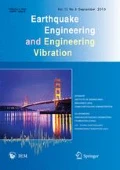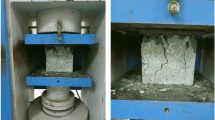Abstract
Seismic capacity, including the ultimate load-carrying capacity and ultimate deformation capacity of precast segmental concrete double-column (PSCDC) piers with steel sleeve (SS) connection or grouted corrugated-metal duct (GCMD) connection, has been verified to be similar to those of cast-in-place (CIP) piers by quasi-static tests. However, the lack of knowledge of seismic response characteristics and damage process of PSCDC piers has limited their application in high-intensity seismic areas. Therefore, shake table tests, using variable types and intensities of seismic ground motions, were performed to investigate the seismic behavior of connection joints and to evaluate the seismic performance of PSCDC piers with SS and GCMD connections. Also, a finite element analysis (FEA) model was developed to study the influence of design parameters on the seismic behavior of the piers. The results showed that the main damage in PSCDC piers was caused by the cyclic opening and closing of connection joints. Under high-intensity ground motions, the PSCDC piers had a lower seismic performance than the CIP piers due to a significant decrease of their integrity and stiffness. The seismic performance of PSCDC piers is comparable to CIP piers when using an appropriate initial stress of the prestressing tendons.
Similar content being viewed by others
References
Ameli MJ, Parks JE, Brown DN and Pantelides CP (2014), “Grouted Splice Sleeve Connection Alternatives for Precast Reinforced Concrete Bridge Piers in Moderate-to-High Seismic Regions,” NCEE 2014 — 10th U.S. National Conference on Earthquake Engineering: Frontiers of Earthquake Engineering, Department of Civil and Environmental Engineering, University of Utah, UT; 84112, United States.
Ameli MJ, Parks JE, Brown DN, et al. (2015), “Seismic Evaluation of Grouted Splice Sleeve Connections for Reinforced Precast Concrete Column-to-Cap Beam Joints in Accelerated Bridge Construction,” PCI Journal, 60(2): 80–103.
Ameli MJ and Pantelides CP (2017), “Seismic Analysis of Precast Concrete Bridge Columns Connected with Grouted Splice Sleeve Connectors,” Journal of Structural Engineering, 143(2): 04016176.
Bu ZY and Ou YC (2013), “Simplified Analytical Pushover Method for Precast Segmental Concrete Bridge Columns,” Advances in Structural Engineering, 16(5): 805–822.
Bu ZY, Guo J, Zheng R, Song J and Lee GC (2016), “Cyclic Performance and Simplified Pushover Analyses of Precast Segmental Concrete Bridge Columns with Circular Section,” Earthquake Engineering and Engineering Vibration, 15(2): 297–312.
Bu ZY, Ou YC, Song JW, et al. (2016), “Cyclic Loading Test of Unbonded and Bonded Posttensioned Precast Segmental Bridge Columns with Circular Section,” Journal of Bridge Engineering, 21(2): 04015043.
Chou CC and Hsu CP (2008), “Hysteretic Model Development and Seismic Response of Unbonded Post-Tensioned Precast CFT Segmental Bridge Columns,” Earthquake Engineering and Structural Dynamics, 37(6): 919–934.
Federal Highway Administration (FHWA) (2009), Connection Details for Prefabricated Bridge Elements and Systems, FHWA-IF-09-010, Washington, D.C.
ElGawady MA and Sha’lan A (2011), “Seismic Behavior of Self-Centering Precast Segmental Bridge Bents,” Journal of Bridge Engineering, 16(3): 328–339.
Ge JP (2008), “Experimental Study and Theoretical Analysis on Seismic Performance of Precast Segmental Piers,” Doctoral Dissertation, Tongji University, Shanghai. (in Chinese)
Guerrini G, Restrepo JI, Massari M, et al. (2015), “Seismic Behavior of Posttensioned Self-Centering Precast Concrete Dual-Shell Steel Columns,” Journal of Structural Engineering, 141(4): 04014115.
Kashani MM, Gonzalez-Buelga A, Thayalan RP, et al. (2018), “Experimental Investigation of a Novel Class of Self-Centring Spinal Rocking Column,” Journal of Sound and Vibration, 437: 308–324.
Khaleghi, B, Schultz E, Seguirant S, et al. (2012), “Accelerated Bridge Construction in Washington State: from Research to Practice,” PCI Journal, 57(4): 34–49.
Kim TH, Lee HM, Kim YJ and Shin HM (2010), “Performance Assessment of Precast Concrete Segmental Bridge Columns with a Shear Resistant Connecting Structure,” Engineering Structures, 32(5): 1292–1303.
Li TT, Qu HY, Wang ZQ, et al. (2018), “Seismic Performance of Precast Concrete Bridge Columns with Quasi-Static Cyclic Shear Test for High Seismic Zones,” Engineering Structures, 166: 441–453.
Marriott D, Pampanin S and Palermo A (2011), “Biaxial Testing of Unbonded Post-Tensioned Rocking Bridge Piers with External Replicable Dissipaters,” Earthquake Engineering and Structural Dynamics, 40(15): 1723–1741.
Marsh, ML, Wernli M, Garrett BE, et al. (2011), “Application of Accelerated Bridge Construction Connections in Moderate-to-High Seismic Regions,” NCHRP Report 698, Transportation Research Board, Washington, DC, USA.
Mazzoni S, McKenna F, Scott MH, et al. (2007), Open Sees Command Language Manual, Pacific Earthquake Engineering Research Center, Univ. of California, Berkeley.
Ministry of Transport of the People’s Republic of China (2008), Guidelines for Seismic Design of Highway Bridge (JTG/T B02-01-2008), Beijing: China Communication Press. (in Chinese)
Motaref S, Saiidi MS and Sanders D (2014), “Shake Table Studies of Energy-Dissipating Segmental Bridge Columns,” Journal of Bridge Engineering, 19(2): 186–199.
Pang JBK, Eberhard MO and Stanton JF (2010), “Large-Bar Connection for Precast Bridge Bents in Seismic Regions,” Journal of Structural Engineering, 15(3): 231–239.
Qu HY, Li TT, Wang ZQ, et al. (2018), “Investigation and Verification on Seismic Behavior of Precast Concrete Frame Piers Used in Real Bridge Structures: Experimental and Numerical Study,” Engineering Structures, 154: 1–9.
Salami MR, Kashani MM and Goda K (2019), “Influence of Advanced Structural Modeling Technique, Main Shock-After Shock Sequences, and Ground-Motion Types on Seismic Fragility of Low-Rise RC Structures,” Soil Dynamics and Earthquake Engineering, 117: 263–279.
Scott MH and Fenves GL (2006), “Plastic Hinge Integration Methods for Force-Based Beam-Column Elements,” Journal of Structural Engineering, 132(2): 244–252.
Scott MH, Franchin P, Fenves GL, et al. (2004), “Response Sensitivity for Nonlinear Beam-Column Elements,” Journal of Structural Engineering, 130(9): 1281–1288.
Shanghai Urban-Rural Construction and Management Committee (2015), Technical Specification for Prefabricated Bridge Pier (DGTJ 08–2160-2015), Shanghai: China Communications Press. (in Chinese)
Shim C, Lee S, Park S, et al. (2017), “Experiments on Prefabricated Segmental Bridge Piers with Continuous Longitudinal Reinforcing Bars,” Engineering Structures, 132: 671–683.
The Ministry of Housing and Urban-Rural Development of the People’s Republic of China (2014), Design Specification for Concrete Structures (GB 50010-2010-2014), Beijing: China Communications Press. (in Chinese)
Thonstad T, Mantawy IM, Stanton JF, et al. (2016), “Shaking Table Performance of a New Bridge System with Pretensioned Rocking Columns,” Journal of Bridge Engineering, 21(4): 04015079.
Thonstad T, Kennedy BJ, Schaefer JA, et al. (2017), “Cyclic Tests of Precast Pretensioned Rocking Bridge-Column Subassemblies,” Journal of Structural Engineering, 143(9): 04017094.
Wang JC, Ou YC, Chang KC and Lee GC (2008), “Large-Scale Seismic Tests of Tall Concrete Bridge Columns with Precast Segmental Construction,” Earthquake Engineering and Structural Dynamics, 37(12): 1449–1465.
Wang ZQ, Song W, Wang YY, et al. (2011), “Numerical Analytical Model for Seismic Behavior of Prestressing Concrete Bridge Column Systems,” Procedia Engineering, 14: 2333–2340.
Wang ZQ, Qu HY, Li TT, et al. (2018), “Quasi-Static Cyclic Tests of Precast Bridge Columns with Different Connection Details for High Seismic Zones,” Engineering Structures, 158: 13–27.
Wilson AG (2010), “Emulative Precast Bent Cap Connections for Seismic Regions: Component Tests-Preliminary Grouted Duct Specimen (unit 5),” Doctoral Dissertation, California State University, Sacramento.
Acknowledgment
The authors gratefully acknowledge the financial support provided by the Natural Science Foundation of China (NSFC) under Grant No. 51408360 and the Technology Project of Xiamen Construction Bureau (XJK) under Grant No. XJK2017-1-4. The authors’ view and opinions expressed in this paper do not necessarily reflect the views of NSFC and XJK.
Author information
Authors and Affiliations
Corresponding author
Additional information
Supported by: Natural Science Foundation of China (NSFC) under Grant No. 51408360 and Technology Project of Xiamen Construction Bureau (XJK) under Grant No. XJK2017-1-4
Rights and permissions
About this article
Cite this article
Zhanghua, X., Jiping, G., Youqin, L. et al. Shake table study on precast segmental concrete double-column piers. Earthq. Eng. Eng. Vib. 19, 705–723 (2020). https://doi.org/10.1007/s11803-020-0590-x
Received:
Accepted:
Published:
Issue Date:
DOI: https://doi.org/10.1007/s11803-020-0590-x




